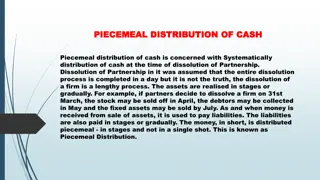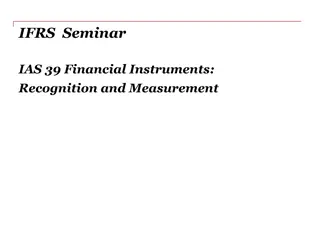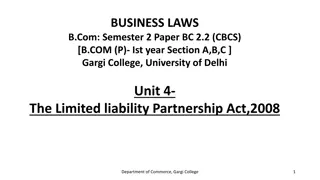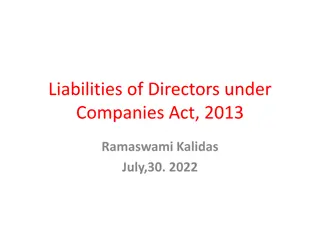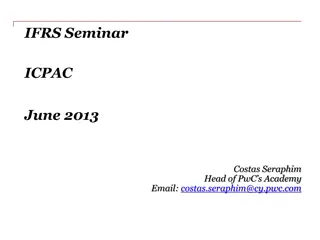Limited Liabilities Partnership
Limited Liability Partnership (LLP) is a unique business structure that combines aspects of a traditional partnership and a limited liability corporation. It offers partners the benefits of limited liability while providing flexible management and tax options. This structure is commonly utilized by professionals such as lawyers, accountants, and consultants to protect personal assets. LLP aims to blend the advantages of traditional partnerships with the security of limited liability companies, allowing professionals to exercise expertise without personal asset risks.
Download Presentation

Please find below an Image/Link to download the presentation.
The content on the website is provided AS IS for your information and personal use only. It may not be sold, licensed, or shared on other websites without obtaining consent from the author.If you encounter any issues during the download, it is possible that the publisher has removed the file from their server.
You are allowed to download the files provided on this website for personal or commercial use, subject to the condition that they are used lawfully. All files are the property of their respective owners.
The content on the website is provided AS IS for your information and personal use only. It may not be sold, licensed, or shared on other websites without obtaining consent from the author.
E N D
Presentation Transcript
Limited Liabilities Partnership Mr. Tanjib-ul Alam Barrister-at-Law Senior Advocate, Supreme Court of Bangladesh
What is Limited Liability Partnership (LLP) Objectives of LLP Characteristics of an LLP: Difference between LLP and Traditional Partnership as envisaged in the Partnership Act, 1932 Contents Development of LLPs in UK, Singapore and India: Importance of LLPs in the context of CA Firms and Law Firms Bangladesh and Limited Liability Partnership
What is Limited Liability Partnership (LLP) A unique business structure combining the elements of both a traditional partnership and a limited liability corporation. Designed to offer the benefits of limited liability to its partners while also allowing for flexible management and taxation options. Commonly used by professionals and service providers, such as lawyers, accountants, consultants, and healthcare practitioners. 3 Tanjib-ul Alam, Barrister
Objectives of LLP: To obtain benefits of both traditional partnerships and limited liability company . To allow the professionals to exercise their professional discretion and expertise without being afraid of losing his or her personal assets which may be attached for wrongful or negligent or tortious acts of the other partners over whom he or she had no control 4 Tanjib-ul Alam, Barrister
Characteristics of an LLP Limited Liability o provides limited liability protection to its partners o shields personal assets of the partners from the debts and liabilities incurred in the course of business o restricts the creditors from going after the partners personal assets beyond their respective contributions to the LLP. 5 Tanjib-ul Alam, Barrister
Characteristics of an LLP Structure: o requires at least 02 (two) partners o no limitation on the number of the partners o unlike a general partnership, where all partners have unlimited personal liability, in an LLP, partners' liability is limited to their capital contribution 6 Tanjib-ul Alam, Barrister
Characteristics of an LLP Management: o offers flexibility o the internal structure of LLP can be organized as per mutual agreement o allows the partners to participate in the day-to-day operations and management of the business and the partners can decide on the division of the responsibilities among themselves 7 Tanjib-ul Alam, Barrister
Characteristics of an LLP o unlike a limited liability company, there is no requirement to create a board of directors or officers, making it a suitable choice for professionals who want to maintain control over their business o LLP is absolved from the requirements of board meetings, resolutions, annual meetings meaning less paperwork o as a separate legal entity, LLP s existence is not affected by the entry or exit of its partners 8 Tanjib-ul Alam, Barrister
Characteristics of an LLP Taxation similar to traditional partnerships, LLPs often have a flow- through taxation structure. the business itself does not pay taxes on its profits; instead, profits and losses are passed through to the individual partners, who report them on their personal tax returns 9 Tanjib-ul Alam, Barrister
Difference between LLP and Traditional Partnership Traditional Partnership has no distinct legal status save and except from the partners who form the partnership. On the contrary, LLP is a separate legal entity recognized by the statute which is not dependent on its partners. Partners of a Traditional Partnership have personal liability, both joint and several, for all the debts incurred in the course of business, i.e., each partner can be sued for the full amount of any claim against the partnership 10 Tanjib-ul Alam, Barrister
Development of LLPs in UK, India and Singapore: United Kingdom: Limited Liability Partnership Act was passed in 2000. Three principles- limited liability, corporate personality and partnership flexibility LLP has its own distinct rights and liabilities Taxed as a traditional partnership Needs to be registered with the Companies House Procedure for winding up or dissolution of LLP is similar to that of the companies Any changes to the registered office address or details of the members is required to be reported to the Companies House Required to file statement of annual accounts along with an Annual Confirmation Statement 11 Tanjib-ul Alam, Barrister
Development of LLPs in UK, India and Singapore : India: LLP was brought within the legal framework by incorporation of the Limited Liability Partnership Act, 2008 which is broadly based on the Limited Liability Partnership Act of the United Kingdom. Applicability of the provisions governing the traditional partnership, i.e., Indian Partnership Act, 1932 has been expressly excluded from the LLP LLPs are required to prepare a statement of account and solvency within 06 months from the end of a financial year which shall be signed by the designated partners of LLP and file the same with the Registrar of Companies 12 Tanjib-ul Alam, Barrister
Development of LLPs in UK, India and Singapore : India: LLPs need to file annual return with the Registrar of Companies within 60 days of closure of its financial year The affairs of the LLP can be investigated by an investigator appointed by the Central Government Authority if the National Company Law Tribunal of India or any Court, either in its own motion or upon receiving an application from at least one-fifth of the total numbers of the partners of the LLP, declares that the affairs of the LLP ought to be investigated. 13 Tanjib-ul Alam, Barrister
Development of LLPs in UK, India and Singapore : India: Allows traditional partnership firms, private company and unlisted public company to convert into an LLP Partners or Creditors of LLPs can enter into a compromised agreement which can be enforced by the National Company Law Tribunal Procedure for winding up or dissolution of LLP is similar to that of the companies 14 Tanjib-ul Alam, Barrister
Development of LLPs in UK, India and Singapore : In Singapore, LLP: was introduced in Singapore pursuant to the enactment of the Limited Liability Partnerships Act, 2005 Needs to be registered, upon completion of which, a Unique Entity Number or UEN is allocated Treated as a separate legal entity 15 Tanjib-ul Alam, Barrister
Development of LLPs in UK, India and Singapore : In Singapore, LLP: Is allowed to do activities such as acquire and hold property in its name and any other activities as legally required No obligation to hold annual general meeting or to file annual accounts and tax returns Required to make an annual declaration about its solvency or insolvency 16 Tanjib-ul Alam, Barrister
Development of LLPs in UK, India and Singapore : In Singapore, LLP: Not affected by inclusion, removal, resignation or death of a partner Inclusion of a new partner requires the consent of all partners and for any other purpose, only obtaining majority vote from the partners shall suffice Procedure for winding up or dissolution of LLP is similar to that of the companies 17 Tanjib-ul Alam, Barrister
Importance of LLPs in the context of CA Firms and Law Firms The professionals such as lawyers, chartered accountant firms, health consultants often prefer to form an LLP because: LLP is also a body corporate, which means it has its existence as compared to the traditional partnership. LLP and its Partners are a distinct entity in the eyes of the law. LLP will know by its name and not the name of its partners. LLPs provide limited liability protection to their partners. This means that the personal assets of the partners are generally protected from the firm's debts and liabilities. In a profession like chartered accountancy or the legal profession where there can be significant financial risks and legal liabilities, this limited liability feature is attractive. LLPs are a suitable legal structure for professional service firms like CA firms and law firms because they allow professionals to form a partnership while enjoying the benefits of limited liability. This structure is especially relevant for CA firms and legal firms where partners may need to collaborate closely on client engagements 18
Importance of LLPs in the context of CA Firms and Law Firms o Operating as an LLP can enhance the professional image and credibility of the CA firm or law firm, as clients may perceive it as a more stable and established business structure o Both LLP and individuals, who own it, are separate elements and both capacities are independent. Obligations for reimbursement and claims brought against the LLP lies on it and not the partners. Any business with potential for claims ought to consider incorporation as it will offer an additional layer of insurance. Hence, an LLP can sue and be sued in its name as it exists as a juristic legal person o As opposed to the traditional partnership, generally there is no limit on the number of the partners of LLP 19
Importance of LLPs in the context of CA Firms and Law Firms o The transferability of a Traditional Partnership is a difficult and lengthy process whereas the share of an LLP can be transferred to another person more easily. An LLP can be converted into a Private Limited Company or a Limited Company easily without any hassle. o LLPs are considered as going concern unless it is wound up. o LLPs allow its partners to choose the structure and method of operation as they deem fit and proper. 20
Bangladesh and Limited Liability Partnership Even though the popularity of LLP is growing rapidly across the globe, the applicable laws of Bangladesh do not recognize the concept of LLP as a separate legal entity. The Partnership Act, 1932 deals with traditional partnership and not the LLP. The legislation should consider following the trend of recognizing LLP as a distinct and separate legal entity and enact appropriate legislation to meet the need of time. 21 Tanjib-ul Alam, Barrister
Bangladesh and Limited Liability Partnership The number of LLPs is rising across the globe. For example, in India, the number of LLPs has been increasing by an approximate average of 35% each year. LLPs as a form of business entity is getting popular as it offers more flexibility to the partners while lowering the compliance and tax requirements. Moreover, till 2014, a number of 2039 partnership firms and companies were converted to LLPs. As the Partnership Act, 1932 offers no immunity to a partner for the liability arising out of the conduct of another partner, therefore, in the event of any litigation, being a partner of a traditional partnership with unlimited liability not only possesses great risk, but also highly discouraging. Due to the growth in economy of Bangladesh, the number of professionals as well as the number of small business enterprises are rising and LLP, which offers a perfect blend of both Limited Liability Company and Traditional Partnership, has become a necessity of time. 22 Tanjib-ul Alam, Barrister



